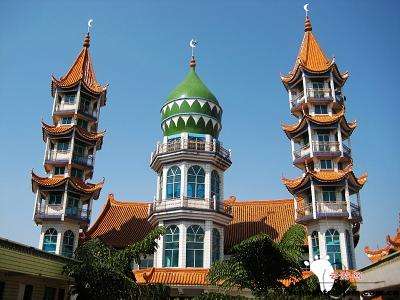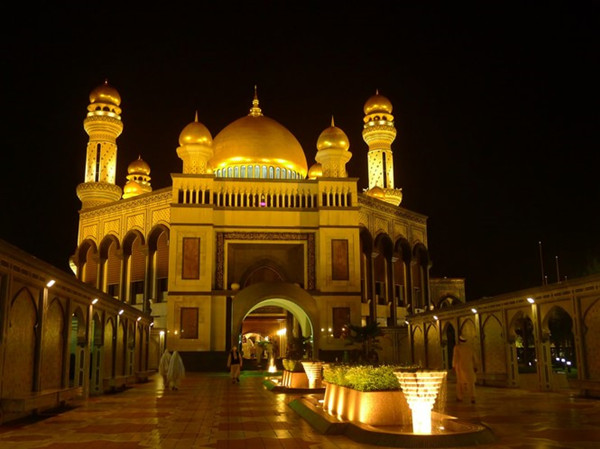
Top Muslim Mosques in Baoshan
As vital carriers of multiethnic culture in western Yunnan, the mosques in Baoshan (保山) preserve the historical memory of Hui (回族) migration, trade, and religious integration. This section explores their unique value through historical development, architectural characteristics, and cultural significance.
Historical Context: From Caravan Stations to Cultural Landmarks
Baoshan Mosque (保山清真寺), Longyang District
As the core symbol of Hui culture in Baoshan (保山), this mosque dates back to the 25th year of the Daoguang reign (1845). It suffered major damage during the “Yongchang Incident” and was rebuilt in the 18th year of the Guangxu reign (1892), standing as a testament to the resilience of Yunnan’s Hui community. During the Republic of China era, renowned Ahong Na Runzhang (纳润章) taught here for 16 years, promoting a blend of Islamic and Confucian learning known as “Hui-Confucian dual cultivation.” In 2021, it was recognized as a “National Advanced Religious Collective,” serving as a model for ethnic unity.
Dongting Mosque (动廷清真寺), Changning County
Built in 1946, Dongting Mosque is a spiritual hub for the Hui community in Changning County (昌宁县). It features a Qing-era couplet: “The Dao came from the West, spanning Tang, Song, Yuan, Ming, and Qing, eternally guiding the faithful; Grace flowed to the East, anchored in prayer, fasting, and moral conduct,” blending Confucian symmetry with Islamic doctrine. Its wooden-brick structure, transitioning from five to seven sections, integrates Bai-style decorative beams with Islamic geometric patterns, embodying the architectural pluralism of western Yunnan.
Xishan Village Mosque (西山村清真寺), Shidian County
Constructed during the Xianfeng reign of the Qing Dynasty, this mosque exemplifies the “settlement around the mosque” pattern. A stone inscription titled “Following Ancient Origins” records that the local Hui migrated from the Central Plains with General Mu Ying (沐英) during the Ming dynasty and later joined trade caravans, embodying a dual livelihood of farming and commerce. Local buildings, such as the Ma Family Residence and Yuan Family Courtyard, blend the solidity of Yi “earthen roof houses” with the elegance of Hui residences, illustrating the pattern of “wide intermixing, localized clustering.”
Tengcheng Mosques (腾城清真寺), Tengchong City

Architectural Features: Spatial Dialogues of Civilizations
Traditional Forms and Local Innovations
Baoshan Mosque (保山清真寺) features a traditional Chinese hip-and-gable roof, with a mihrab and minbar strictly following Islamic design. Uniquely, it integrates Han-style caisson ceilings with Arabic calligraphy, expressing the cosmological concept of “heaven is round, earth is square.”
Xishan Village Mosque (西山村清真寺) blends the Bai-style “three rooms and one screen wall” layout with Yi rammed-earth roofing techniques, making it resilient against western Yunnan’s rainy climate. The mosque’s grey tiles and white walls reflect the Islamic values of simplicity and cleanliness.
Localization of Religious Symbols
At Dongting Mosque (动廷清真寺), Arabic plaques coexist with Confucian couplets. At Deqin Mosque (德钦清真寺), a white stupa stands beside the prayer hall. These “symbolic overlays” illustrate Islam’s adaptive transformation in the Tibetan-Yi corridor. For example, the cross-shaped motif atop Heshun Mosque (和顺清真寺) is actually a localized misinterpretation of the Islamic “Tree of Life” totem—an example of vivid cross-cultural exchange.

 7 Days GolfingTour
7 Days GolfingTour
 8 Days Group Tour
8 Days Group Tour
 8 Days Yunnan Tour
8 Days Yunnan Tour
 7 Days Shangri La Hiking
7 Days Shangri La Hiking
 11 Days Yunnan Tour
11 Days Yunnan Tour
 6 Days Yuanyang Terraces
6 Days Yuanyang Terraces
 11 Days Yunnan Tour
11 Days Yunnan Tour
 8 Days South Yunnan
8 Days South Yunnan
 7 Days Tea Tour
7 Days Tea Tour
 8 Days Muslim Tour
8 Days Muslim Tour
 12 Days Self-Driving
12 Days Self-Driving
 4 Days Haba Climbing
4 Days Haba Climbing
 Tiger Leaping Gorge
Tiger Leaping Gorge
 Stone Forest
Stone Forest
 Yunnan-Tibet
Yunnan-Tibet
 Hani Rice Terraces
Hani Rice Terraces
 Kunming
Kunming
 Lijiang
Lijiang
 Shangri-la
Shangri-la
 Dali
Dali
 XishuangBanna
XishuangBanna
 Honghe
Honghe
 Kunming
Kunming
 Lijiang
Lijiang
 Shangri-la
Shangri-la
 Yuanyang Rice Terraces
Yuanyang Rice Terraces
 Nujiang
Nujiang
 XishuangBanna
XishuangBanna
 Spring City Golf
Spring City Golf
 Snow Mountain Golf
Snow Mountain Golf
 Stone Mountain Golf
Stone Mountain Golf


















